
Bruce Estes Grooms, is a retired vice admiral in the United States Navy. His last duty station before retirement was as Deputy Chief of Staff for Capability Development at Allied Command Transformation. He retired in June 2015.
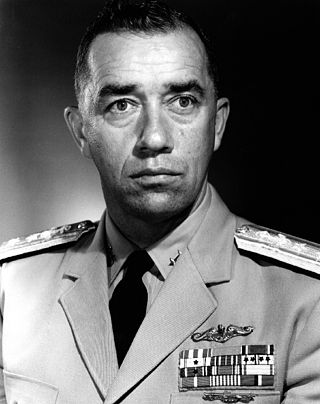
Eugene Parks "Dennis" Wilkinson was a United States Navy officer. He was selected for three historic command assignments. The first, in 1954, was as the first commanding officer of USS Nautilus, the world's first nuclear-powered submarine. The second was as the first commanding officer of USS Long Beach, America's first nuclear surface ship. The third was in 1980 when he was chosen as the first President and CEO of the Institute of Nuclear Power Operations (INPO) from which he retired in 1984.

Rear Admiral Jay Allan DeLoach served as the Director of Naval History and Director of the Naval History and Heritage Command and the Curator of the Navy from 2008 to 2012. He was an American submarine officer who played a role in implementing a visionary "Memorandum of Understanding" between the Submarine Force Active component and the Reserve component. He helped pioneer many key initiatives that have since been adopted Navy-wide. DeLoach was the Assistant Deputy Chief of Naval Operations for Resources, Requirements and Assessments.
Hispanic and Latino Admirals in the United States Navy can trace their tradition of naval military service to the Latino sailors, who have served in the Navy in every war and conflict since the American Revolution. Prior to the Civil War, the highest rank reached by a Latino-American in the Navy was commodore. Such was the case of Commodore Uriah Phillips Levy (1792–1862), a Sephardic Jew of Latin American descent and great grandson of Dr. Samuel Nunez, who served in the War of v. During the American Civil War, the government of the United States recognized that the rapid expanding Navy was in need of admirals therefore, Congress proceeded to authorize the appointment of nine officers the rank of rear admiral. On July 16, 1862, Flag Officer David Glasgow Farragut became the first Hispanic-American to be appointed to the rank of rear admiral. Two years later (1864), Farragut became a vice admiral, and in 1866 the Navy's first full admiral. During World War I, Robert Lopez, the first Hispanic graduate of the United States Naval Academy, served with the rank of commodore in command of the Mare Island Naval Shipyard, and during World War II five Hispanics served with the ranks of rear admiral or above in either the European or Pacific Theaters of the war. As of April 2007, twenty-two Hispanic-Americans have reached the rank of admiral, and of this number thirteen were graduates of the USNA.
Hispanics in the United States Naval Academy account for the largest minority group in the institution. According to the academy, the Class of 2009 includes 271 (22.2%) minority midshipmen. Out of these 271 midshipmen, 115 are of Hispanic heritage. In 2004, of the total of 736 female midshipmen, 74 (10%) of them were of Hispanic descent.
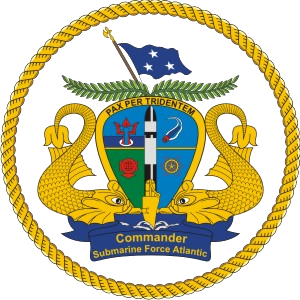
Commander, Submarine Force Atlantic (COMSUBLANT) is the Submarine Force U.S. Atlantic Fleet type commander under the United States Fleet Forces Command.

Commander, Submarine Force, U.S. Pacific Fleet (COMSUBPAC) is the principal advisor to the Commander, United States Pacific Fleet (COMPACFLT) for submarine matters. The Pacific Submarine Force (SUBPAC) includes attack, ballistic missile and auxiliary submarines, submarine tenders, floating submarine docks, deep submergence vehicles and submarine rescue vehicles throughout the Pacific.

Kinnaird Rowe McKee was an American United States Navy four star admiral who served as Director, Naval Nuclear Propulsion from 1982 to 1988. He also served as Superintendent, United States Naval Academy from 1975 to 1978.
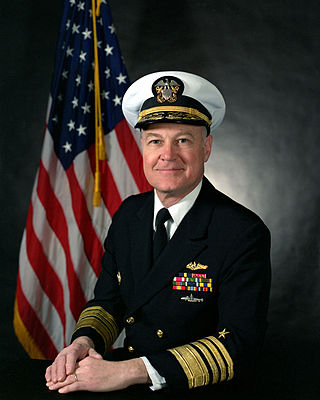
Henry Goodman Chiles Jr. is a retired United States Navy four star admiral who served as Commander in Chief, United States Strategic Command (USCINCSTRAT), from 1994 to 1996, the first naval officer to command all of the strategic nuclear forces of the United States.
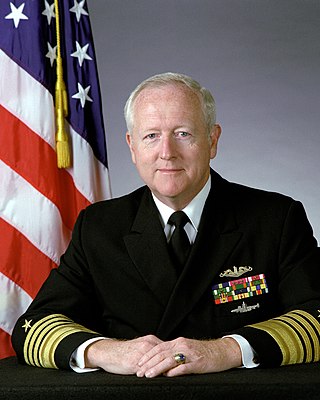
Bruce DeMars is a retired United States Navy four star admiral who served as Director, Naval Nuclear Propulsion from 1988 to 1996.
Hispanics in the United States Navy can trace their tradition of naval military service to men such as Lieutenant Jordi Farragut Mesquida, who served in the American Revolution. Hispanics, such as Seaman Philip Bazaar and Seaman John Ortega, have distinguished themselves in combat and have been awarded the Medal of Honor, the highest military decoration of the United States. Hispanics have also reached the top ranks of the navy, serving their country in sensitive leadership positions on domestic and foreign shores. Among those who have reached the highest ranks in the navy are Commodore Uriah Phillips Levy, of Sephardic and Ashkenazic Jewish descent, who participated in the War of 1812 as an assistant Sailing master; Admiral David Glasgow Farragut, for whom the rank of admiral in the U.S. Navy was created during the American Civil War; and Admiral Horacio Rivero, who led the navy during the Cuban Missile Crisis.

Michael J. Connor, is a retired United States Navy Vice Admiral. Connor held several, concurrent titles during his last assignment including Commander, United States Submarine Forces (COMNAVSUBFOR), Commander, Submarine Forces Atlantic (COMSUBLANT) and Commander, Allied Submarine Command. Connor served as commander of the U.S. submarine forces from September 2012 until September 2015.

Vice Admiral John Jay Donnelly is a retired American submarine officer. A graduate from the U.S. Naval Academy class of 1975, he retired in 2010 after 35 years of service.
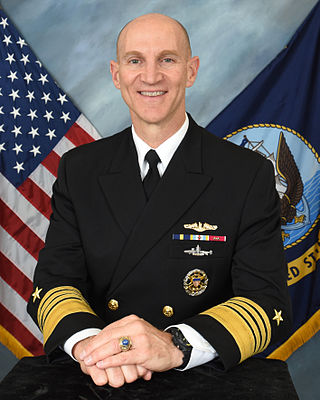
James Franklin "Frank" Caldwell Jr. is an admiral in the United States Navy who currently serves as director of the Naval Nuclear Propulsion Program, a job once held by the program's creator, Admiral Hyman G. Rickover. He previously served as Naval Inspector General.

Alma M. Grocki is a retired United States Navy rear admiral. After graduating from the United States Naval Academy in 1981, she served in a succession of warship and submarine maintenance postings before transferring to the United States Navy Reserve in 1988. Grocki commanded various U.S. Navy facilities, shipyards and programs before becoming director of fleet maintenance for the United States Pacific Fleet and deputy commander of Naval Sea Systems Command.

David Matthew Kriete is a retired vice admiral in the United States Navy who last served as the deputy commander of the United States Fleet Forces Command. He is a graduate of the United States Naval Academy and holds a Master’s degree in Engineering Management from Old Dominion University.

Charles Anthony "Chas" Richard is a retired United States Navy admiral who served as the 11th commander of United States Strategic Command. He previously served as Commander Submarine Forces, Submarine Force Atlantic and Allied Submarine Command.

Randy B. Crites is a vice admiral in the United States Navy, serving as Deputy Chief of Naval Operations for Integration of Capabilities and Resources since May 15, 2020. He previously served as the Deputy Assistant Secretary of the Navy for Budget, and as director of the Fiscal Management Division in Washington, D.C., until he was promoted to the rank of vice admiral in 2020.
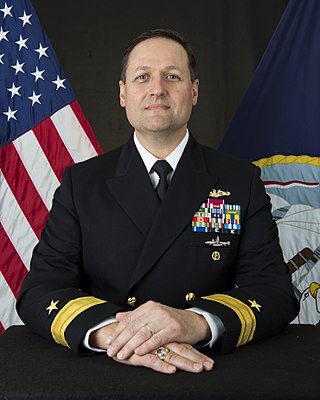
Rear Admiral Edward L. Anderson is an active duty United States Navy officer and career submariner who has been serving as Commander, Undersea Warfare since June 2019.

Daryl Lane Caudle is a United States Navy admiral who is the 35th commander of United States Fleet Forces Command since December 7, 2021. He most recently served as commander of Naval Submarine Forces (COMSUBFOR), Commander, Submarine Force Atlantic (COMSUBLANT) and Commander, Allied Submarine Command (ASC). As COMSUBFOR, he was the undersea domain lead, and is responsible for the submarine force's strategic vision. As COMSUBLANT, he commanded all Atlantic-based U.S. submarines, their crews and supporting shore activities. These responsibilities also include duties as commander, Task Force (CTF) 114, CTF 88, and CTF 46. As commander, Allied Submarine Command, he was the principal undersea warfare advisor to all North Atlantic Treaty Organization (NATO) strategic commanders.


















